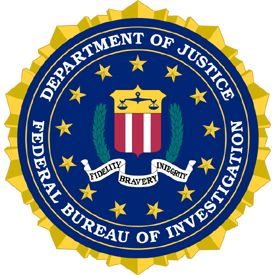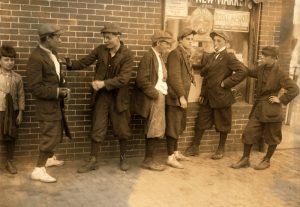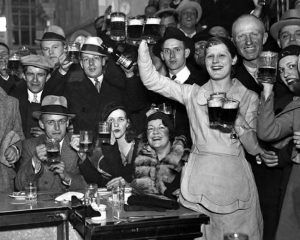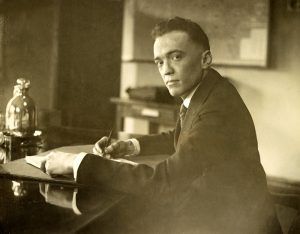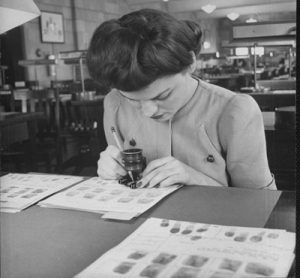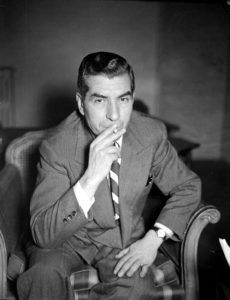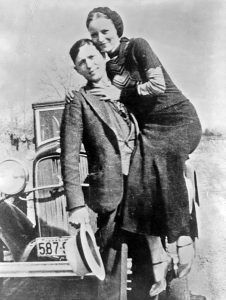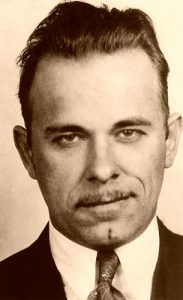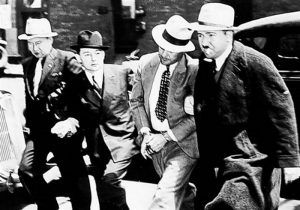The Federal Bureau of Investigation, established in 1908, was designed to fight corruption and crime on a national level. However, when they were established, there were few federal crimes, and the agency focused on violations of federal laws involving national banking, bankruptcy, naturalization, antitrust, and land fraud. And, at that time, there was hardly any systematic way of enforcing the law across the now broad landscape of America. That changed, however, when Prohibition enforcement began in 1920.
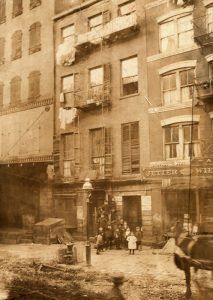
Tenement in New York City by Lewis W. Hine, 1910.
When the FBI began, there were over 100 cities with populations over 50,000 where crime had grown along with them. In these big cities, with their many overcrowded tenements filled with the poor and disillusioned and all the ethnic tensions of an increasingly immigrant nation stirred in for good measure, tempers often flared. Clashes between striking workers and their factory bosses were turning increasingly violent.
But violence was just the tip of the criminal iceberg. Corruption was also rampant nationwide, especially in local politics. Big business also had its share of sleaze, from the shoddy, even criminal, conditions in meat packaging plants and factories to the illegal monopolies threatening to control entire industries.
During these early days, America’s cities and towns were also fast becoming breeding grounds for future professional lawbreakers. In Brooklyn, New York, a nine-year-old Al Capone would soon start his life of crime. In Indianapolis, Indiana, a five-year-old John Dillinger grew up on his family farm. In Chicago, Illinois, a young child christened Lester Joseph Gillis would be born, later morphing into the vicious killer “Baby Face” Nelson.
By the early 1920s, World War I had ended, and Prohibition had begun. The “war to end all wars” was over; a new one was beginning on the streets of America. On one side was a rising tide of professional criminals, made richer and bolder by Prohibition, which had turned the nation “dry” in 1920.
In one big city alone — Chicago — an estimated 1,300 gangs had spread like a deadly virus by the mid-1920s, and there was no easy cure. With wallets bursting from bootlegging profits, gangs outfitted themselves with “Tommy” guns and operated with impunity by paying off politicians and police alike. Rival gangs led by the influential Al “Scarface” Capone and the hot-headed George “Bugs” Moran turned the city streets into a virtual war zone with gangland clashes. By 1926, more than 12,000 murders were occurring annually across America.
On the other side was law enforcement, which was outgunned and ill-prepared at this point in history to take on the surging national crime wave. Dealing with bootlegging and speakeasies was challenging, but the “Roaring Twenties” also saw bank robbery, kidnapping, auto theft, gambling, and drug trafficking become increasingly common crimes. More often than not, local police forces were hobbled by the lack of modern tools and training. And their jurisdictions stopped abruptly at their borders.
In the young Bureau of Investigation, things were not much better. In the early twenties, the agency was no model of efficiency and had a growing reputation for politicized investigations. A good housecleaning was for the Bureau, and it came from a young lawyer named J. Edgar Hoover. Hoover joined the Department of Justice in 1917 and quickly rose through its ranks. In 1921, he was named Assistant Director of the Bureau. Three years later, Attorney General Harlan Stone named him Director. Hoover would go on to serve for nearly another half-century.
At the outset, the 29-year-old Hoover was determined to reform the Bureau quickly and thoroughly to make it a model of professionalism. He did so by weeding out the “political hacks” and incompetents, laying down a strict code of conduct for agents, and instituting regular inspections of Headquarters and field operations. He insisted on rigorous hiring criteria, including background checks, interviews, and physical tests for all special agent applicants. In January 1928, he launched the first formal training for incoming agents, a two-month course of instruction and practical exercises in Washington, D.C. Under Hoover’s direction, new agents were also required to be 25 to 35 years old, preferably with experience in law or accounting.
When Hoover took over in 1924, the Bureau had about 650 employees, including 441 special agents. In five years, with the rash of firings, it had just 339 special agents and less than 600 total employees. But it was beginning to become the organized, professional, and effective force that Hoover envisioned.
A critical step in that direction came during Hoover’s first year at the helm when the Bureau was given the responsibility of consolidating the nation’s two significant collections of fingerprint files from the federal one at Leavenworth, Kansas, and its own set of state and local ones held in Chicago, Illinois. Hoover also welcomed submissions from other jurisdictions and provided identification services to all law enforcement partners.
This was a vital new tool for law enforcement and the first major building block in Hoover’s growing quest to bring the discipline of science to Bureau investigations and scientific services to law enforcement nationwide. Early wanted posters began to include fingerprints and details about criminal suspects on the run, and the Bureau was fast becoming a national hub for criminal records. By 1936, the agency had a total reservoir of 100,000 fingerprint cards; by 1946, that number had swelled to 100 million.
Using fingerprints to catch the guilty and free the innocent was just the beginning. The lawlessness of the 1920s got the nation’s attention, and several independent studies in May 1929 confirmed what everyone seemed to know already — that law enforcement at every level needed to modernize. In 1930, the FBI began to collect national crime statistics that would enable authorities to understand trends and better focus resources. Another significant development was made the following year when the Bureau’s first technical laboratory took root. By 1932, the lab was fully operational and soon providing scientific examinations and analysis for the Bureau and its partners around the country.
These advances came just in time, as the crime wave that began in the 1920s was about to peak. By the early 1930s, cities like St. Paul, Minnesota, had become virtual training grounds for young crooks. At the same time, Hot Springs, Arkansas, had become a safe haven and vacation spot for the criminal underworld.
Al Capone was locked away for good in 1931, but his Chicago Outfit carried on fine without him and would experience a resurgence in the coming decades. The “Five Families” of the New York Mafia were also emerging during this period, with “Lucky” Luciano setting up the “Commission” to unite the mob and “Murder, Inc.” to carry out its hits. Prohibition was ultimately repealed in 1933, but by then, the Great Depression was in full force, and with honest jobs harder to come by than ever, the dishonest ones sometimes seemed more attractive than standing in soup lines.
By 1933, an assortment of dangerous and criminally prolific gangsters was wreaking havoc across America, especially in the Midwest. Their names would soon be known far and wide. With his crooked smile, John Dillinger managed to charm the press and much of America into believing he was nothing more than a harmless, modern-day Robin Hood. In reality, Dillinger and his revolving crew of gunslingers — violent thugs like Homer Van Meter, Harry “Pete” Pierpont, and John “Red” Hamilton — were shooting up banks across America’s heartland, stealing hundreds of thousands of dollars and murdering at least one policeman along the way.
There was also Clyde Barrow and his girlfriend, Bonnie Parker, an inseparable, love-struck couple who sometimes partnered with the Barrow brothers and others, who robbed and murdered their way across a half dozen states.
The ruthless, almost psychopathic “Baby Face” Nelson worked with everyone from Roger “The Terrible” Touhy to Al Capone and John Dillinger throughout his criminal career. He then teamed up with John Paul Chase and Fatso Negri in his latter days. Nelson was a callous killer who thought nothing of murdering lawmen, gunning down three Bureau agents in seven months. And there was the cunning Alvin Karpis and his Barker brother sidekicks, who not only robbed banks and trains but engineered two major kidnappings of wealthy Minnesota business executives in 1933.
These criminals would become “public enemies,” actively hunted by law enforcement nationwide. At first, the Bureau was playing only a bit part in pursuing these gangsters since few of their crimes violated federal laws. But that began to change with the 1932 Lindbergh kidnapping, which gave the Bureau jurisdiction in these cases for the first time; with the “Kansas City Massacre” in June 1933, a bloody slaughter at a train station that claimed the lives of four lawmen, including a Bureau agent; and with the rise to national prominence of John Dillinger.
Using whatever federal laws it could hang its hat on, the Bureau focused on catching these gangsters. And despite some stumbles along the way, the successes began to add up. By the end of 1934, most of these public enemies had been killed or captured.
Bonnie and Clyde were the first to fall, in May 1934, at the hands of Texas lawmen, with the Bureau playing a small supporting role in tracking them down. In July, Melvin Purvis and a team of agents caught up with John Dillinger, who was shot dead leaving a Chicago theater. “Pretty Boy” Floyd, one of the hired hands of the Kansas City Massacre, was killed in a shootout with Bureau agents and local law enforcement on an Ohio farm in October 1934. Nelson died the following month after a bloody firefight with two special agents, who were also killed.
The Bureau caught up with the rest soon enough. Agents arrested “Doc” Barker in January 1935, and the infamous “Ma” Barker and her son Fred were killed by Bureau agents in Florida eight days later. Alvin Karpis, the brains of the gang, was captured in May 1936 and ended up in Alcatraz.
Thanks to the successful battle against gangsters, the once unknown Bureau and its “G-Men” became household names and icons of popular culture in just a few transformative years. Along the way, Congress had given it newfound powers, including the ability to carry guns and make arrests. In July 1935, as the capstone of its newfound identity, the organization was renamed the Federal Bureau of Investigation — the FBI.
As the decade came to a close, the FBI would find itself shifting gears once again. War was brewing in Europe, and pro-Nazi groups were becoming more and more vocal in the U.S., claiming fascism was the answer to American woes. The gangsters, it turned out, were just a prelude to the dark days to come.
Compiled and edited by Kathy Alexander/Legends of America, updated January 2024. Source: Federal Bureau of Investigation
Also See:

